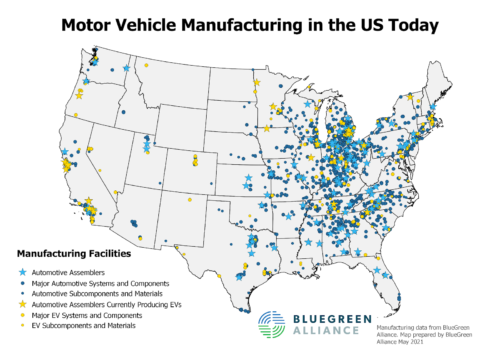WONK WEDNESDAY: Building the Electric Vehicle Fleet of the Future Here (Part One: “The Big Picture”)

The following post is authored by Reem Rayef, BlueGreen Alliance Policy Advisor.
The auto market is changing. As electric vehicles (EVs) plummet in price, local, state and national governments domestically and abroad are using incentives and regulations to speed EV adoption and position their economies to reap the rewards of this industry transformation. Even business as usual forecasting predicts that there will be nearly 20 million EVs on U.S. roads by 2030, and that EVs will make up nearly 60% of global market share by 2040. EVs are on their way to dominating the worldwide passenger vehicle market, representing an important stride toward national and global climate goals. But what will this mean for workers and communities here in the U.S.? That depends on decisions Congress and the Administration make today.
THE FUTURE OF AUTO MANUFACTURING MATTERS
A fair and effective shift to a clean, advanced vehicle fleet necessitates a cohesive suite of policies focused on securing and growing domestic manufacturing and jobs. Today, policymakers face a unique opportunity to preserve and strengthen a critical sector of the economy with the potential to support high-quality jobs and pathways to the middle class. Through a proactive and holistic EV manufacturing strategy, leaders can avoid repeating the mistakes of past decades, when ill-conceived trade, tax, and labor policies gutted auto manufacturing jobs, and undermined wages and working conditions. By contrast, failure to act means losing market share to our global competitors (who are actively supporting their manufacturing economies at this critical nexus) and jeopardizing jobs in the single largest sector of U.S. manufacturing.
Proactive side-by-side investments in both EV deployment and EV manufacturing can support workers while making critical climate progress. Along with a new generation of vehicle standards to chart the stepwise transition to a cleaner nationwide fleet, we need an equally robust investment in transforming vehicle and component manufacturing to ensure that working people and communities have a seat at the table, and see the benefits of the next generation of transportation technology.
THE AMERICAN JOBS PLAN AND EVs
The Biden Administration’s American Jobs Plan (AJP) calls for an over $300B investment to strengthen American manufacturing. As Congress considers the critical infrastructure, manufacturing, and public services investments needed for a lasting economic recovery, policymakers should commit at least $60 billion—as part of the larger manufacturing commitment—to strengthen domestic EV manufacturing and supply chains, including funds targeted to rebuild manufacturing communities, strengthen supplier networks, and improve job quality, equity, and community benefits. This at least $60B manufacturing investment is crucial to supplement the $174 billion of EV deployment and infrastructure provisions laid out in the AJP, and includes the following elements:
- Loans and other financial support to expand, or retool, or establish domestic production of advanced and electric vehicles, major components, and advanced materials throughout the auto supply chain;
- Conversion and retooling grants to leverage recently-closed or at-risk auto manufacturing facilities and their workforces to build the fleet of the future;
- Tax credits to support the domestic production of critical EV components and subcomponents, and to bring new production to scale;
- Targeted supply chain investments to fill strategic gaps in EV technology manufacturing and materials production.
As part of an overall clean transportation strategy, these measures comprise an essential package of policies that will secure family-supporting jobs—and create new ones— while helping transform transportation technology and meet our climate goals.
WHAT’S AT STAKE
A thriving domestic EV market and supply chain is within our reach, but not without immediate action. A recent backgrounder report from BGA, United Auto Workers, the AFL-CIO Industrial Union Council, and United Steelworkers details the opportunities and risks to workers and domestic manufacturing in the shift to EVs. Under business-as-usual policy, in the shift from the internal combustion engine and powertrain, to the batteries and cells of an electric propulsion system the U.S. risks continuing to lose jobs and market share to other nations making proactive investments in EV and EV technology manufacturing. Smart policy must not only seek to onshore production of EV batteries, cells, and other technology critical to the EV value chain; there is also far more to be done to reverse the trend of offshored production throughout the automotive sector, and to remove the pressures that have cut wages, damaged working conditions, and driven disinvestment in manufacturing communities.
The auto industry is economically critical. It represents the largest single sector of American manufacturing, and employment. Today, more than 1 million manufacturing workers build vehicles and the components and technology that go into them, and about 1 in 20 workers is supported by the domestic auto sector, from raw materials mining and steelmaking to engines and batteries to final assembly and dealerships—and all the local businesses that support them. This means that supplying domestic demand for EVs with American innovation, American manufacturing, and family-supporting, union jobs will be essential. Congress has the power to help ensure that American communities and workers have access to the opportunities arising from this industry transformation, rather than facilitating the flight of good jobs to Asia and Europe, where key elements of the EV value chain are currently concentrated, and where policymakers are taking stronger actions to spur the production of key technologies. The jobs at stake are geographically and sectorally dispersed, meaning that their benefits extend well beyond those communities surrounding the major assemblers (see Figure 1).
Done right, holistic investments in domestic EV manufacturing and the automotive supply chain can help sustain hundreds of thousands of jobs, and support an equitable manufacturing strategy that avoids past mistakes and addresses past harms.
Elevating and Implementing U.S. Automotive Manufacturing Sector Investments in the American Jobs Plan
The Biden Administration’s recovery priorities, as outlined in the American Jobs Plan (AJP), reflect a clear focus on the need for U.S. leadership in the global market shift to EVs. The AJP proposes a $174 billion investment that will bolster the U.S. market for EVs through three main mechanisms: consumer point-of-sale rebates and incentives to buy American-made EVs, federal procurement actions to electrify federal fleets, and grants and incentive programs for the establishment of a robust and resilient nation-wide charging network. These three mechanisms should be championed by Congress; they position the U.S. to become a leading market for the next generation of vehicles and to help make EVs an economical and practical choice for all.
But America’s clean transportation future won’t be realized by spurring deployment of advanced vehicles and building necessary charging infrastructure, alone.
The AJP also demonstrates the Biden Administration’s strong commitment to American manufacturing through interwoven Buy America/domestic procurement and high quality manufacturing job creation commitments, and over $300B targeted spending in the broader American manufacturing sector, including segments of the auto supply chain like semiconductor manufacturing. The Administration’s articulated support for clean vehicle manufacturing tax credits, incentives for new battery production facilities, loans for advanced vehicle manufacturing, and retooling of at-risk factories also represents a decisive move in the right direction for workers and the economy. Finally, we laud the Administration’s report on its 100 day review of the battery and critical supply chain, which called for actions to onshore and expand responsible domestic production in these instrumental areas.
The automotive transformation that we need for the health of our economy and our climate relies on each of these elements and tactics. It will be critical for Congress to fully fund a comprehensive investment strategy that will enable a domestic auto manufacturing transformation at a scale commensurate with the shift in vehicle deployment.
Proactive investment—at least $60B in funding over 10 years—targeted to strengthen domestic EV manufacturing and supply chains—is urgently needed to ensure that rapidly accelerating domestic and global demand for EVs do not leave U.S. manufacturing workers and communities behind. Congress must act quickly to ensure that as drivers look to replace the nearly 300 million internal combustion engine (ICE) vehicles on the road today, the domestic auto supply chain—and auto workers across America—are well-positioned to build the fleet of the future.
In Part Two of this blog series, we discuss the urgent policy priorities needed to ensure we’re building America’s EV future here.
